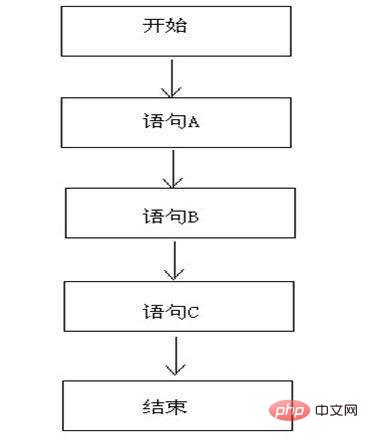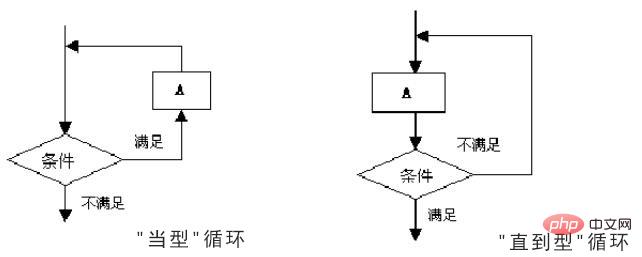What are the process structures of PHP?
PHP has three process structures: 1. Sequential structure. Each operation in the program is executed top to bottom according to the order in which they are arranged in the source code. 2. The branch structure is used to judge given conditions and then control the flow of the program; the branch structure will judge based on a specific condition and then select one of them for execution. 3. Loop structure refers to a program structure that requires repeated execution of one or more operations in the program until the condition is false or true.

The operating environment of this tutorial: windows7 system, PHP8 version, DELL G3 computer
Process control is a means of controlling the program. If the program is gone For process control, there would be no programming language. Most programs are not controlled by linear execution statements. If the program needs to communicate with the user, the execution sequence must be determined based on user input, and the code may even need to be executed repeatedly. These are all inseparable from process control.
There are three basic program structures in PHP: sequential structure, branch structure, and loop structure.
1. Sequential structure
The sequential structure is the simplest program structure. Each operation in the program is based on their order in the source. The order of arrangement in the code is from top to bottom and executed sequentially.
The flow chart is as follows:

Example:
<?php //实现$a和$b的值互换 $a=3; $b=4; $c=$a; $a=$b; $b=$c; echo'$a='.$a; echo"<br/>"; echo'$b='.$b; ?>
2. Selection structure (branch structure )
The branch structure is also called the conditional structure. It selects the execution path based on clear conditions, rather than strictly following the order. In actual programming, the appropriate one should be selected according to the program flow. A branch statement is a program that changes execution according to the result of a condition.
The flow chart is as follows:

Example:
<?php
$t=date("H");
if ($t>"18") {
echo "晚上好!";
}
?>3. Loop structure
The loop structure refers to a program structure that requires repeated execution of one or more operations in the program until the condition is false or true.
It determines whether to continue executing a certain function or to exit the loop based on the conditions in the loop body. According to the judgment conditions, the loop structure can be subdivided into the following two forms:
When type loop structure: judge (condition) first and then execute.
Until loop structure: execute first and then judge.
The loop structure can be regarded as a combination of a conditional judgment statement and a turnaround statement. In addition, there are three elements of the loop structure: loop variables, loop body and loop termination condition. The loop structure is represented by a judgment box in the program block diagram. The conditions are written in the judgment box. The two exits correspond to the conditions being established and the conditions not being established respectively. Among the different instructions executed at the time, one of them should point to the loop body, and then return from the loop body to the entrance of the judgment box.
The flow chart is as follows:

"When type" loop: execute block A when the given conditions are met, otherwise block A will not be executed and will jump directly to the following part for execution.
"Until" loop: Its meaning is: execute block A until the given condition is met (block A will no longer be executed if the condition is met).
provided by php There are three types of loops: while loop, do-while loop, and for loop
Example 1:
<?php
header("Content-type:text/html;charset=utf-8");
$i = 1;
$sum=0;
while($i<=100){
$sum+=$i;
$i++;
}
echo "1加到100的值为:".$sum ;
?>Output result:
1加到100的值为:5050
Example 2: Calculate the sum from 1 to 100
<?php
header("Content-type:text/html;charset=utf-8");
$i = 1;
$sum=0;
do {
$sum += $i;
$i++;
} while ($i <= 100);
echo '1 + 2 + 3 +...+ 99 + 100 = '. $sum;
?>Output result:
1 + 2 + 3 +...+ 99 + 100 = 5050
Example 3: Find the product of 1 times 100 (factorial of 100)
<?php
$sum=1;
for($i=1; $i<=100; $i++){
$sum*=$i;
}
echo '1 * 2 * 3 *...* 99 * 100 = '. $sum;
?>Output:
1 * 2 * 3 *...* 99 * 100 = 9.3326215443944E+157
Recommended learning: "PHP Video Tutorial"
The above is the detailed content of What are the process structures of PHP?. For more information, please follow other related articles on the PHP Chinese website!

Hot AI Tools

Undresser.AI Undress
AI-powered app for creating realistic nude photos

AI Clothes Remover
Online AI tool for removing clothes from photos.

Undress AI Tool
Undress images for free

Clothoff.io
AI clothes remover

AI Hentai Generator
Generate AI Hentai for free.

Hot Article

Hot Tools

Notepad++7.3.1
Easy-to-use and free code editor

SublimeText3 Chinese version
Chinese version, very easy to use

Zend Studio 13.0.1
Powerful PHP integrated development environment

Dreamweaver CS6
Visual web development tools

SublimeText3 Mac version
God-level code editing software (SublimeText3)

Hot Topics
 1386
1386
 52
52
 PHP 8.4 Installation and Upgrade guide for Ubuntu and Debian
Dec 24, 2024 pm 04:42 PM
PHP 8.4 Installation and Upgrade guide for Ubuntu and Debian
Dec 24, 2024 pm 04:42 PM
PHP 8.4 brings several new features, security improvements, and performance improvements with healthy amounts of feature deprecations and removals. This guide explains how to install PHP 8.4 or upgrade to PHP 8.4 on Ubuntu, Debian, or their derivati
 How To Set Up Visual Studio Code (VS Code) for PHP Development
Dec 20, 2024 am 11:31 AM
How To Set Up Visual Studio Code (VS Code) for PHP Development
Dec 20, 2024 am 11:31 AM
Visual Studio Code, also known as VS Code, is a free source code editor — or integrated development environment (IDE) — available for all major operating systems. With a large collection of extensions for many programming languages, VS Code can be c
 7 PHP Functions I Regret I Didn't Know Before
Nov 13, 2024 am 09:42 AM
7 PHP Functions I Regret I Didn't Know Before
Nov 13, 2024 am 09:42 AM
If you are an experienced PHP developer, you might have the feeling that you’ve been there and done that already.You have developed a significant number of applications, debugged millions of lines of code, and tweaked a bunch of scripts to achieve op
 How do you parse and process HTML/XML in PHP?
Feb 07, 2025 am 11:57 AM
How do you parse and process HTML/XML in PHP?
Feb 07, 2025 am 11:57 AM
This tutorial demonstrates how to efficiently process XML documents using PHP. XML (eXtensible Markup Language) is a versatile text-based markup language designed for both human readability and machine parsing. It's commonly used for data storage an
 Explain JSON Web Tokens (JWT) and their use case in PHP APIs.
Apr 05, 2025 am 12:04 AM
Explain JSON Web Tokens (JWT) and their use case in PHP APIs.
Apr 05, 2025 am 12:04 AM
JWT is an open standard based on JSON, used to securely transmit information between parties, mainly for identity authentication and information exchange. 1. JWT consists of three parts: Header, Payload and Signature. 2. The working principle of JWT includes three steps: generating JWT, verifying JWT and parsing Payload. 3. When using JWT for authentication in PHP, JWT can be generated and verified, and user role and permission information can be included in advanced usage. 4. Common errors include signature verification failure, token expiration, and payload oversized. Debugging skills include using debugging tools and logging. 5. Performance optimization and best practices include using appropriate signature algorithms, setting validity periods reasonably,
 PHP Program to Count Vowels in a String
Feb 07, 2025 pm 12:12 PM
PHP Program to Count Vowels in a String
Feb 07, 2025 pm 12:12 PM
A string is a sequence of characters, including letters, numbers, and symbols. This tutorial will learn how to calculate the number of vowels in a given string in PHP using different methods. The vowels in English are a, e, i, o, u, and they can be uppercase or lowercase. What is a vowel? Vowels are alphabetic characters that represent a specific pronunciation. There are five vowels in English, including uppercase and lowercase: a, e, i, o, u Example 1 Input: String = "Tutorialspoint" Output: 6 explain The vowels in the string "Tutorialspoint" are u, o, i, a, o, i. There are 6 yuan in total
 Explain late static binding in PHP (static::).
Apr 03, 2025 am 12:04 AM
Explain late static binding in PHP (static::).
Apr 03, 2025 am 12:04 AM
Static binding (static::) implements late static binding (LSB) in PHP, allowing calling classes to be referenced in static contexts rather than defining classes. 1) The parsing process is performed at runtime, 2) Look up the call class in the inheritance relationship, 3) It may bring performance overhead.
 What are PHP magic methods (__construct, __destruct, __call, __get, __set, etc.) and provide use cases?
Apr 03, 2025 am 12:03 AM
What are PHP magic methods (__construct, __destruct, __call, __get, __set, etc.) and provide use cases?
Apr 03, 2025 am 12:03 AM
What are the magic methods of PHP? PHP's magic methods include: 1.\_\_construct, used to initialize objects; 2.\_\_destruct, used to clean up resources; 3.\_\_call, handle non-existent method calls; 4.\_\_get, implement dynamic attribute access; 5.\_\_set, implement dynamic attribute settings. These methods are automatically called in certain situations, improving code flexibility and efficiency.




